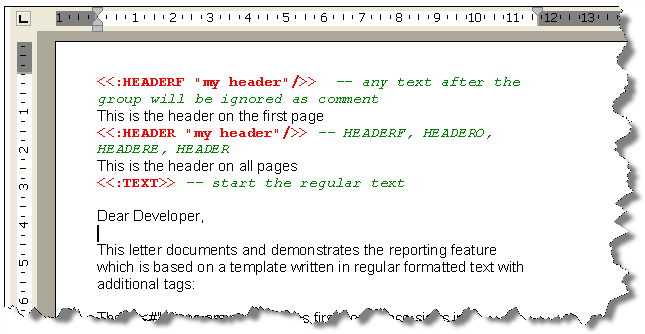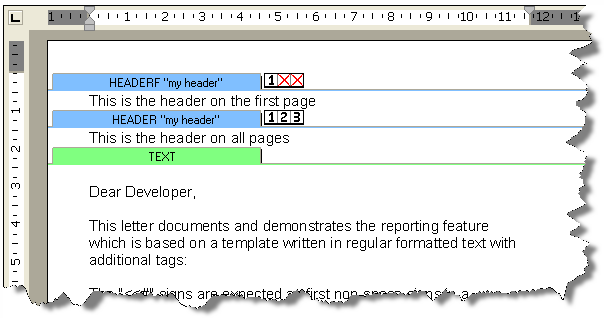<<:HEADERF "my header"/>> -- any text after the group will be ignored as comment This is the header on the first page <<:HEADER "my header"/>> -- HEADERF, HEADERO, HEADERE, HEADER This is the header on all pages <<:TEXT>> -- start the regular text
Dear Developer,
This letter documents and demonstrates the reporting feature which is based on a template written in regular formatted text with additional tags:
The "<<#" signs are expected as first non-space signs in a paragraph. Any text after the closing >> signs is ignored and can be used as comment. Fields are inserted between the signs << and >>. It is important that after the '<<' no white space or punctuation is written.
Headers in groups are written using single, not open/closing tags. They cannot be nested anyway. The / before the closing >> signs should be added but is not required.
Only groups are nestable. Groups are started using the code <<#. The name after the # sign will be the group name, so a database name can be used. An optional alias can be specified. It is possible to set up a list of possible group names.
Now our list starts:
<<#GROUP1 ?name#null "Invoice">> -- the table will be given the display name "invoice", the logical names remains "GROUP1". After the optional name a condition is expected. <<:HEADER/>> -- this header will be displayed at the start of the group Group Header. Fields are possible: <<fieldname +spc/>> <<:DATA ?"has orders"=null/>> -- this is the data row. Some data here - under condition that there are no orders. (Note that a field name may used spaces. In this case use " in the field name part as well.) <<:DATA ?hasorders#null/>> -- this is the data row. Some data here - under condition there are orders. <<:FOOTER/>> -- this footer will be displayed at the end of the group Group Footer. Fields are possible: <<fieldname/>> <<#/GROUP1>> -- close the group.
This text comes after the group.
|
When viewed with activated the syntax highlighting the document will look like

Note: The syntax highlighter does not make any modifications to the attributes of the text. All highlighting is done just visual and is updated while the text is edited.
After the conversion to the internal reporting template structure the document looks like this:
